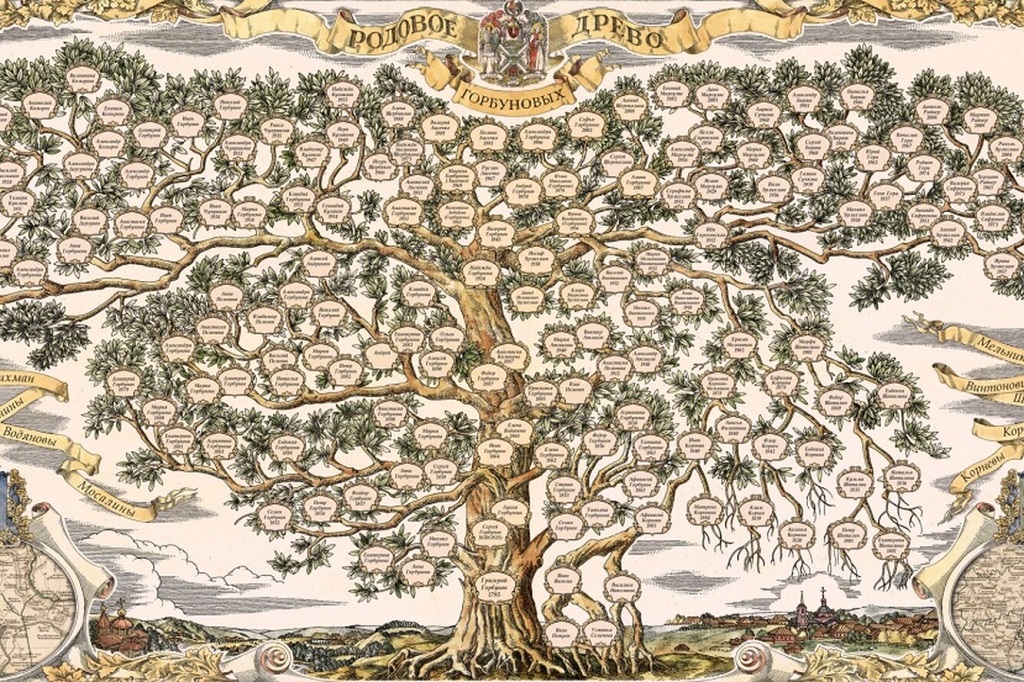I continue to develop the concept of a custom data warehouse, which can form the basis of the My Visual Multibase project. Below is a description of the implementation of three more possibilities:
- Inheritance of class properties
- Displaying child objects along with their parents
- Extension of basic data types: adding the “Date” type.
Property inheritance
Let me remind you that the principle of inheritance is one of the principles of the object-oriented approach in programming (you can read more about the development of this concept in the article “The Evolution of Abstractions”). And this mechanism really helps save time when creating child classes. Let’s look at this with an example.
It is quite obvious that the ancestor class must have at least two common properties that will be useful to all descendants:
- Unique identificator
- Name
The unique identifier is implemented as an object.id field, which is not editable. But the name is stored in the cproperty table, along with the other properties of the object. This is necessary so as not to further complicate the methods for generating table views, editing forms and filling out drop-down lists for reference values.
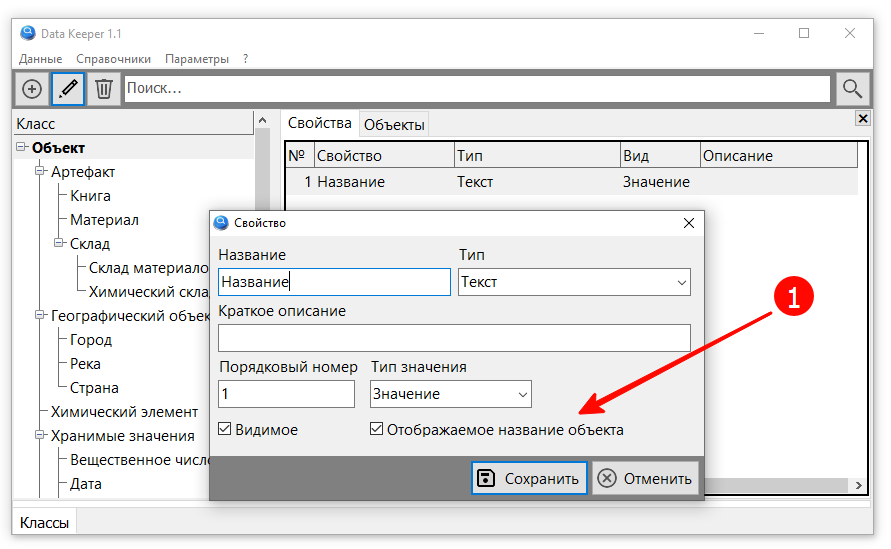
It should be noted that only this property has the “Object Display Name” checkbox checked. The probability that the root object can have other properties is non-zero, so let it be for now.
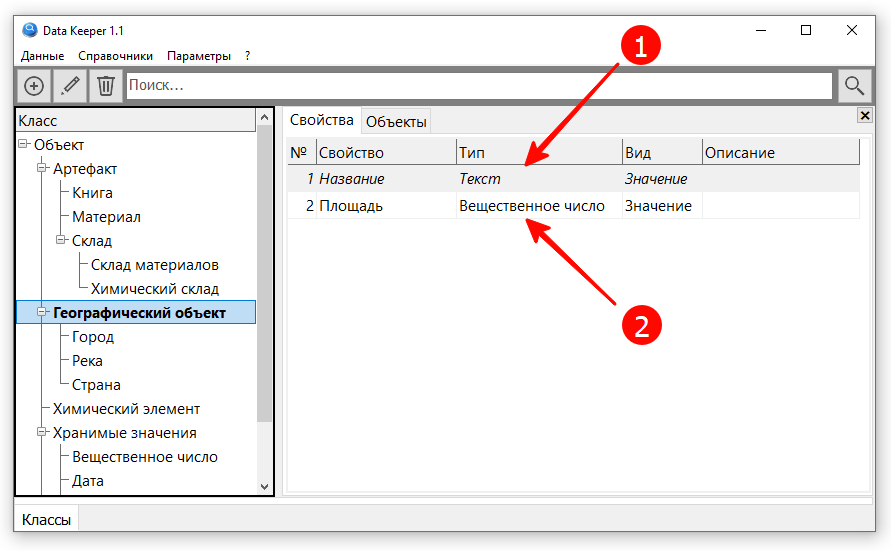
When describing a geographical object, the “Name” property is already present in the list of properties (1) and is highlighted in italics, which indicates the inheritance of this property from an ancestor. All that remains is to add a new property – “Area”.
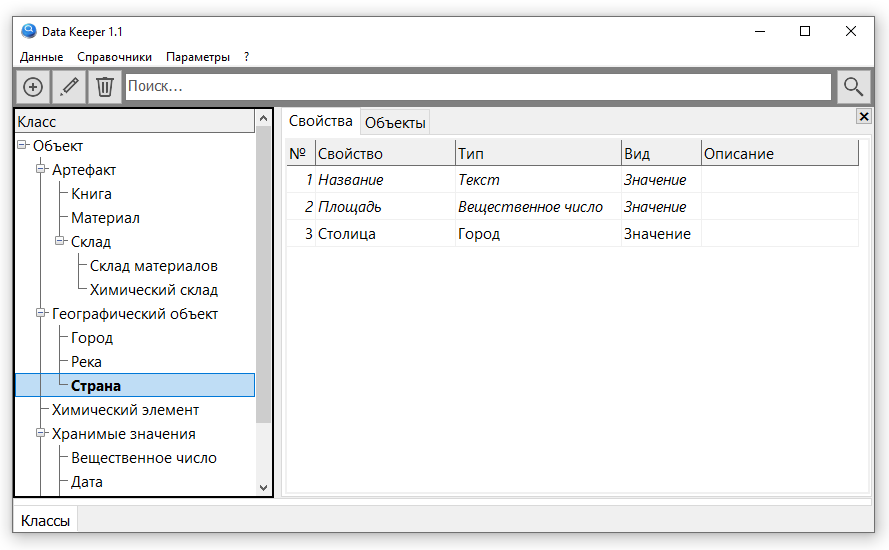
The “Country” class inherits two properties: “Name” and “Area”, and has its own property “Capital”, which is a reference to an object of the “City” class.
In order for this mechanism to work, changes were required in the procedures responsible for displaying the list of properties: in tabular form on the “Properties” tab; list of columns on the “Objects” tab; list of editing components on the efmObject form. Now, instead of filtering properties by a specific class, you filter by a list of IDs, which contains the ID of the displayed class and the IDs of all its ancestors.
We also had to replace the dynamic form dtfCProperty with the static frmCProperty, in which data is displayed using an SQL query
select
cproperty.id,
cproperty.id_class,
cproperty.orderNum,
cproperty.name,
class.name as className,
ptype.name as ptypeName,
cproperty.description
from cproperty
left join class on class.id = cproperty.id_class1
left join ptype on ptype.id = cproperty.id_ptype
where id_class in ( {edtIDMaster} )
order by orderNum Code language: SQL (Structured Query Language) (sql)The frmCProperty.edtIDMaster component contains a list of IDs. The current implementation of the class tree does not allow generating this list using an SQL query (which suggests switching to an interval tree), so you have to create it using a script using the TdbTreeView.GetParent() method:
procedure frmCProperty_btnUpdate_OnClick (Sender: TObject; var Cancel: boolean);
var
tmpTree: TdbTreeView;
s: string;
tmpIndex: integer;
tmpForm: TForm;
tmpLevel: integer;
begin
tmpForm := GetFormByName('dtfClass_Tree');
if tmpForm <> nil then
begin
tmpTree := TdbTreeView( Form_GetDataViewer( tmpForm ) );
// collect IDs from the node and all parent nodes
tmpIndex := tmpTree.SelectedRow;
if tmpIndex = -1 then
frmCProperty.edtIDMaster.Text := '-1'
else
begin
s := '';
repeat
if s <> '' then
s := s+','
else
frmCProperty.edtIDClass.Value := tmpTree.dbIndexToID( tmpIndex );
s := s + IntToStr( tmpTree.dbIndexToID( tmpIndex ) );
tmpIndex := tmpTree.GetParent( tmpIndex );
until tmpIndex < 0;
frmCProperty.edtIDMaster.Text := s;
end;
// collecting child IDs
tmpIndex := tmpTree.SelectedRow;
if tmpIndex = -1 then
frmCProperty.edtIDChilds.Text := '-1'
else
begin
tmpLevel := tmpTree.GetLevel( tmpIndex );
s := '';
repeat
if s <> '' then
s := s+',';
s := s + IntToStr( tmpTree.dbIndexToID( tmpIndex ) );
inc(tmpIndex);
until (tmpIndex = tmpTree.RowCount) or ( tmpTree.GetLevel( tmpIndex ) <= tmpLevel );
frmCProperty.edtIDChilds.Text := s;
end;
end;
end;
Code language: JavaScript (javascript)In the same script, a list of child nodes is generated, which uses the TdbTreeView.GetLevel() method. This list will be useful to us for displaying objects.
Displaying Child Objects
We modify frmObject_btnUpdate_OnClick() so that the list of objects displays objects of both the selected class itself and all its descendants:
procedure frmObject_btnUpdate_OnClick (Sender: TObject; var Cancel: boolean);
// update table view
var
tmpIDClass: integer;
tmpDataSet: TDataSet;
tmpSQL: string;
tmpFields : string;
tmpJoins: string;
tmpCount: integer;
tmpCaptions: string;
tmpTableAlias: string;
tmpButton: TdbButton;
tmpIDClassList: string;
tmpIDChildList: string;
begin
frmObject.labIDClass.Caption := 'Change'; // block the event processing of frmObject_tgrMain_OnColumnResize
// a query is built to select data - all objects of the specified class
tmpIDClass := Form_GetDataViewer( GetFormByName('dtfClass_Tree') ).dbItemId;
frmObject.labIDClass.Tag := tmpIDClass; // запоминаем класс
tmpIDClassList := frmCProperty.edtIDMaster.Text; // список классов
tmpIDChildList := frmCProperty.edtIDChilds.Text; // список классов
tmpSQL := 'SELECT * FROM cproperty WHERE id_class in ('+tmpIDClassList+') ORDER BY orderNum ';
SQLQuery(tmpSQL,tmpDataSet);
tmpFields := 'object.id';
tmpJoins := '';
tmpCaptions := 'delete_col'; // не отображать
tmpCount := 0;
//
while not tmpDataSet.EOF do
begin
if tmpDataSet.FieldByName('visible').asInteger = 1 then
begin
tmpTableAlias := 'OP_'+IntToStr(tmpCount);
//
if tmpFields <> '' then
tmpFields := tmpFields + ', ';
tmpFields := tmpFields + tmpTableAlias+'.value_s ';
//
tmpJoins := tmpJoins + 'LEFT JOIN oproperty '+tmpTableAlias+' ON '+tmpTableAlias+'.id_object = object.id AND '+tmpTableAlias+'.id_cproperty = '+tmpDataSet.FieldByName('id').asString+CR ;
//
if tmpCaptions <> '' then
tmpCaptions := tmpCaptions + ', ';
tmpCaptions := tmpCaptions + tmpDataSet.FieldByName('name').asString;
//
inc(tmpCount);
end;
tmpDataSet.Next;
end;
tmpDataSet.Free;
tmpSQL := 'SELECT '+tmpFields+CR+' FROM object '+tmpJoins+CR+' WHERE object.id_class in ('+tmpIDChildList+')';
tmpButton := TdbButton(Sender);
tmpButton.dbSQL := tmpSQL;
tmpButton.dbListFieldsNames := tmpCaptions;
end;Code language: Delphi (delphi)Now in the list of objects you can see how objects of the selected class…
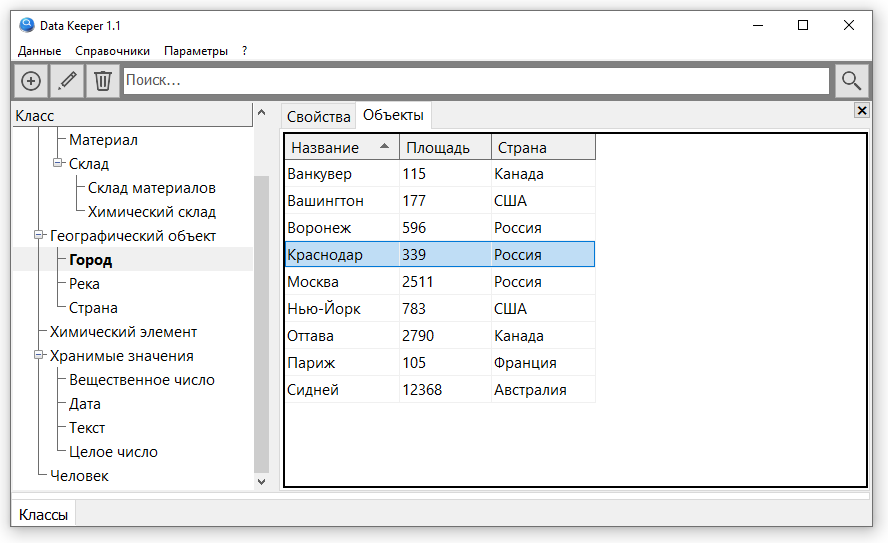
…as well as all objects of child classes:

Date data type
Add the type to the visual components directory.
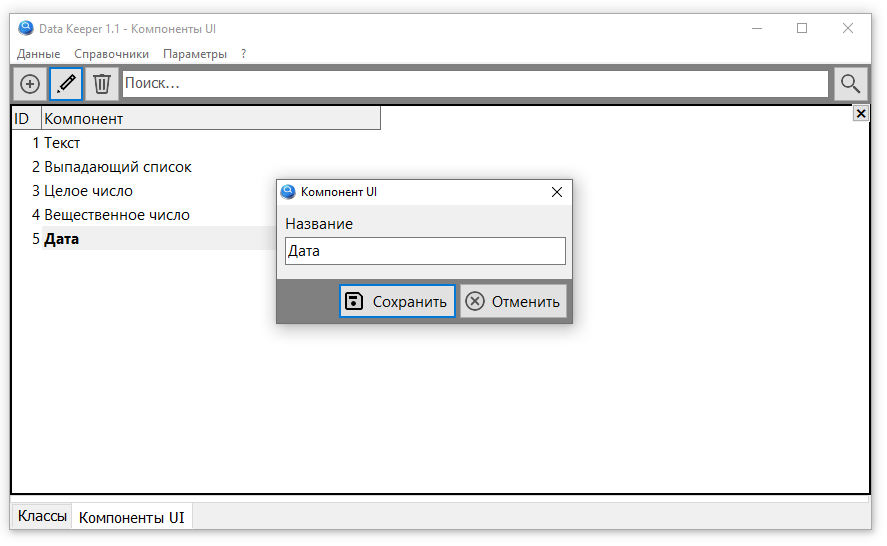
Then we add a new class to store date data.
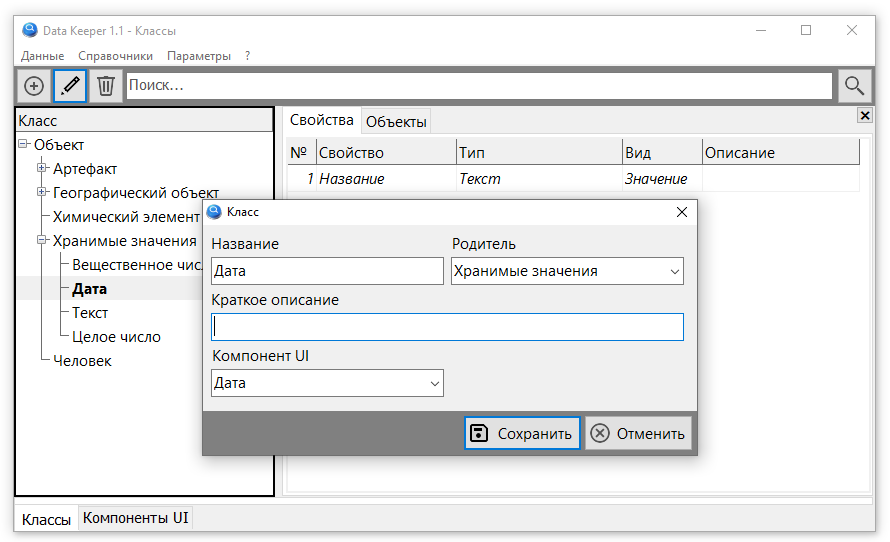
Now we add the procedure for generating components on the object editing form, adding the creation of a component for entering the date.
By the way, we had to change the concept of building the form, namely, to abandon the removal of unnecessary components in favor of their reuse. This is due to a bug within MVDB that causes the TdbComboBox.Free method to throw an Access Violation if you ever open the combobox’s dropdown list. However, there is also a plus in this approach – the form opens faster and memory fragmentation is reduced.
procedure efmObject_OnShow (Sender: TObject; Action: string);
// display the editing form
var
i: integer;
tmpSQL: string;
tmpIDClass: integer;
tmpCount: integer;
tmpLabel: TdbLabel;
tmpEdit: TdbEdit;
tmpComboBox: TdbComboBox;
tmpForm: TForm;
tmpParent: TdbPanel;
tmpDataSet: TDataSet;
tmpID: string;
tmpControlID: integer;
tmpIDClassList: string;
tmpDataEdit : TdbDateTimePicker;
begin
tmpIDClassList := frmCProperty.edtIDMaster.Text; // список классов
tmpForm := TForm(Sender);
tmpParent := efmObject.panEdit;
if Action = 'NewRecord' then
begin
efmObject.cmbClass.dbItemID := Form_GetDataViewer( GetFormByName('dtfClass_Tree') ).dbItemId;
end;
// hide all components
for i := tmpParent.ControlCount - 1 downto 0 do
begin
tmpParent.Controls[i].Visible := False;
end;
tmpIDClass := efmObject.cmbClass.dbItemID;
tmpCount := 0;
// create the components that are needed to edit the properties of the current object
tmpSQL := 'SELECT cproperty.id, cproperty.name, cproperty.is_name, class.name as cname, class.id_uicontrol, class.id as ClassID '+
'FROM cproperty LEFT JOIN class ON class.id = cproperty.id_class1 WHERE id_class in ('+tmpIDClassList+') ORDER BY orderNum ';
SQLQuery(tmpSQL,tmpDataSet);
while not tmpDataSet.EOF do
begin
tmpControlID := tmpDataSet.FieldByName('id_uicontrol').asInteger;
// метка
FindC(tmpForm,'labData_'+intToStr(tmpCount),tmpLabel,False);
if tmpLabel = nil then
tmpLabel := TdbLabel.Create( tmpForm );
with tmpLabel do
begin
visible := True;
parent := tmpParent;
Font.Size := 11;
top := tmpCount * 50;
left := 8;
name := 'labData_'+intToStr(tmpCount);
Caption := tmpDataSet.FieldByName('name').asString;
if tmpDataSet.FieldByName('is_name').asInteger = 1 then
Font.Style := fsBold
else
Font.Style :=0;
end;
// Edit
FindC(tmpForm,'edtData_'+intToStr(tmpCount),tmpEdit,False);
if tmpEdit = nil then
tmpEdit := TdbEdit.Create( tmpForm );
with tmpEdit do
begin
visible := True;
name := 'edtData_'+intToStr(tmpCount);
parent := tmpParent;
Font.Size := 11;
top := tmpCount * 50 + tmpLabel.Height;
left := 8;
width := 300;
tag := tmpDataSet.FieldByName('id').asInteger; //
tagString := VarToStr( SQLExecute('SELECT id FROM oproperty WHERE id_object = '+IntToStr( efmObject.btnSave.dbGeneralTableId )+' AND id_cproperty = '+tmpDataSet.FieldByName('id').asString ) );
text := VarToStr( SQLExecute('SELECT value_s FROM oproperty WHERE id_object = '+IntToStr( efmObject.btnSave.dbGeneralTableId )+' AND id_cproperty = '+tmpDataSet.FieldByName('id').asString ) );
dbCurrency := False;
NumbersOnly := False;
if tmpControlID = 3 then // Integer number
begin
dbCurrency := True;
dbAccuracy := 0;
Alignment := taLeftJustify;
end;
if tmpControlID = 4 then // Real Number
begin
NumbersOnly := True;
end;
onChange := 'efmObject_edtEdit_OnChange';
Font.Style := 0;
end;
// ComboBox
if tmpControlID = 2 then
begin
//
FindC(tmpForm,'cmbData_'+intToStr(tmpCount),tmpComboBox,False);
if tmpComboBox = nil then
tmpComboBox := TdbComboBox.Create( tmpForm );
with tmpComboBox do
begin
visible := True;
name := 'cmbData_'+intToStr(tmpCount);
parent := tmpParent;
Font.Size := 11;
top := tmpCount * 50 + tmpLabel.Height;
left := 8;
width := 300;
tagString := VarToStr( SQLExecute('SELECT id_object1 FROM oproperty WHERE id_object = '+IntToStr( efmObject.btnSave.dbGeneralTableId )+' AND id_cproperty = '+tmpDataSet.FieldByName('id').asString ) );
dbSQL := 'SELECT object.id, oproperty.value_s FROM object LEFT JOIN oproperty ON oproperty.id_object = object.id WHERE oproperty.id_cproperty = ( SELECT id FROM cproperty WHERE cproperty.is_name = 1 ) AND object.id_class = '+tmpDataSet.FieldByName('ClassID').asString+' ORDER BY 2';
dbUpdate;
if tagString <> '' then // если есть ссылочное значение, то синхронизировать выпадающий список
dbItemID := StrToInt(tagString);
onChange := 'efmObject_cmbEdit_OnChange';
Font.Style :=0;
end;
end;
// Date
if tmpControlID = 5 then
begin
FindC(tmpForm,'dtpData_'+intToStr(tmpCount),tmpDataEdit,False);
if tmpDataEdit = nil then
begin
tmpDataEdit := TdbDateTimePicker.Create( tmpForm );
AssignEvents(tmpDataEdit);
end;
with tmpDataEdit do
begin
visible := True;
name := 'dtpData_'+intToStr(tmpCount);
parent := tmpParent;
Font.Size := 11;
top := tmpCount * 50 + tmpLabel.Height;
left := 8;
width := 300;
ShowCheckBox := True;
if ValidDate( tmpEdit.Text ) then
begin
DateTime := StrToDate( tmpEdit.Text );
Checked := True;
end
else
Checked := False;
//
dbOnChange := 'efmObject_dtpEdit_OnChange';
Font.Style :=0;
end;
end;
inc(tmpCount);
tmpDataSet.Next;
end;
tmpDataSet.Free;
tmpForm.ClientHeight := tmpCount * 50 + 48; // adjust the height of the form
end;
Code language: Delphi (delphi)The date can be entered or not entered – the TdbDateTimePicker component checker is responsible for this

Column width
The column width of a class table view is no longer tied to any specific class property, since different classes can now have the same (inherited) properties. This circumstance led to a change in the data structure and the algorithm for saving data on setting column widths, which are now stored in the class.col_widths field.
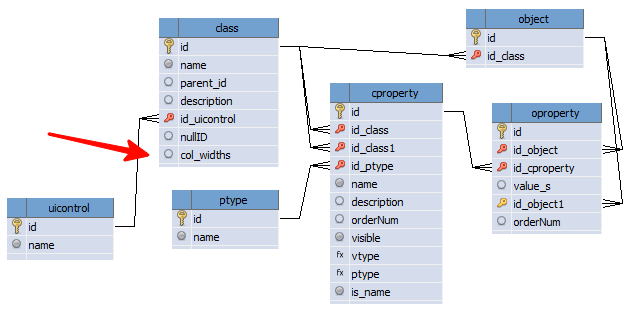
The data is stored as a string with integer values separated by commas. Modified procedures for loading and saving the setting are given below.
procedure frmObject_tgrMain_OnChange (Sender: TObject);
// updating data in a table
var
tmpIDClass: integer;
tmpSQL: string;
tmpColumn: integer;
s: string;
tmpColWidth: array of string;
begin
// get ID
tmpIDClass := frmObject.labIDClass.Tag;
// read column widths from base
tmpSQL := 'SELECT COALESCE(col_widths,"") FROM class WHERE id = '+IntToStr(tmpIDClass);
s := SQLExecute(tmpSQL);
tmpColWidth := SplitString(s,',');
for tmpColumn := 0 to frmObject.tgrMain.Columns.Count - 1 do
begin
if tmpColumn < length(tmpColWidth) then
frmObject.tgrMain.Columns[tmpColumn].Width := StrToInt(tmpColWidth[tmpColumn] )
else
frmObject.tgrMain.Columns[tmpColumn].Width := 200;
end;
frmObject.labIDClass.Caption := ''; // unlock frmObject_tgrMain_OnColumnResize
end;
procedure frmObject_tgrMain_OnColumnResize (Sender: TObject; ACol: Integer);
// column resize
var
tmpIDClass: integer;
tmpSQL : string;
i: integer;
s: string;
begin
if frmObject.labIDClass.Caption = '' then
begin
s := '';
for i:=0 to frmObject.tgrMain.Columns.Count - 1 do
s := s + IntToStr(frmObject.tgrMain.Columns[i].Width) + ',';
delete(s,length(s),1);
// remember the widths of all columns in the database
tmpIDClass := frmObject.labIDClass.Tag; // класс
tmpSQL := 'UPDATE class SET col_widths = "'+s+'" WHERE id = '+IntToStr(tmpIDClass);
SQLExecute(tmpSQL);
end;
end;
Code language: Delphi (delphi)Results
The Data Keeper project is developing, algorithms for generating and retrieving data are being refined.
What should be done:
- Set property support
- Interval class tree
- Searching for objects by a given property value (several properties)
- Displaying dependent objects (objects for which this object is the value of a property)
- Creation of arbitrary views (using an analogue of SQL for OOP).
- Filtering (automatic construction of a filter panel for objects of a given class based on a list of properties)
- Flag for mandatory completion of an object property (analogous to a required field)
- Flag of the uniqueness of a property of a class object (analogous to the uniqueness of a field value)
- Global uniqueness flag of an object property (or property with GUID generation)
- Extension of basic data types (time, yes/no, images/files, etc.)
- Adding control for data types (analogous to domains) – range of values for numbers and dates, text length for strings, etc.
- Manually adjusting the position and size of components on the class editing form.
- Adding new reference values directly from the object editing form.
Links
- Data Keeper 1.1 – project sources
